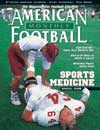AMERICAN FOOTBALL MONTHLY THE #1 RESOURCE FOR FOOTBALL COACHES
Article CategoriesAFM Magazine
|
PrehabilitationInjury prevention using the weight roomby: Lisa Holcomb, CSBC © More from this issue There are many goals that the weight room and conditioning fields wish to obtain in order to increase the strength, stamina and speed of a football team. One of the most important facets, however, lies in their ability to prevent injury. By properly utilizing available resources, it is possible to recognize and steer away from potential injuries that could eventually take away from the team's caliber. This type of preventive measure is known in the field as prehabilitation. It is important to be able to recognize the most common reasons for an athlete to be sidelined, and then do all things possible to avoid them. Neck For example, it is common in a collision sport such as football for neck injuries to occur. Several simple neck exercises exist that may help reduce the severity of such an injury. Various comp....The full article can only be seen by subscribers. Subscribe today!
|
|
|||||||
| HOME |
MAGAZINE |
SUBSCRIBE | ONLINE COLUMNISTS | COACHING VIDEOS |
Copyright 2025, AmericanFootballMonthly.com
All Rights Reserved





